Kabaddi often seen as an ancient wrestling sport is an Indian contact team sport, played between two teams of seven players that is indeed very popular not just only in India but various South Asian countries.
The word Kabaddi comes from a Tamil word, ‘Kai-pidi’ which means ‘holding hands’. Apart from this sport being the national sport of Bangladesh, it is also very popular in various Indian states of Andhra Pradesh, Haryana, Punjab, Kerala, Bihar, Maharashtra, Uttar Pradesh, Telangana and Odisha.
History
There are many theories about the origin of this sport, but the most popular theories of some religious believers are that this game originated either from the Vedic period of ancient India or the Sistan region of the present day Iran.
Despite the presence of these conflicting theories, India is mainly credited with popularising the Kabaddi as a competitive sport. India was the first country to organise Kabaddi competitions that date way back to the 1920’s , introducing Kabaddi in the Indian Olympics Games in 1938, creating an All-India Kabaddi Federation in 1950, playing it as a demonstration sport for the purpose of promoting it at the Asian Games in 1951 held at New Delhi.
After demonstrating the game again at the Asian Games held at Delhi in 1982, Kabaddi was officially added to the Asian Games programme in 1990.
Types of Kabaddi
There are multiple iterations of Kabaddi, but all of them are divided into 2 types- ‘standard style’, where the game is played on a rectangular court indoors. This style of Kabaddi is used in all major professional leagues and international competitions. The other type of Kabaddi is known as ‘Circle Style’ Kabaddi. This type is not used in any professional league, it is rather a traditional style of playing the sport mostly in India’s Punjab region.
Standard Style rules
The game is played with 20-minute halves with a 5-minute half break in which the teams exchange sides. During each play, known as a “raid”, a player from the attacking side, known as the “raider”, runs into the opposing team’s side of the court and attempts to tag as many of the seven defending players as far as possible for a raider.
During the raid, the raider usually chants the phrase “Kabaddi kabaddi kabaddi….” confirming to referees that their raid is done on a single breath without inhaling until he/she reaches his/her side.
For a raid to be eligible for points, the raider must cross the baulk line in the defending team’s territory, and return to their half of the field without being tackled (note that if an attacker touches a defender and hasn’t yet reached the baulk line, they don’t need to reach the baulk line to score points and may return to their half of the court). A 30-second ‘Shot Clock’ is also enforced on each raid.
A point is scored for each defender tagged. If the raider steps beyond the bonus line marked in the defending team’s territory, they earn an additional point known as a bonus point. If the raider is successfully stopped, the opposite team to earn a point instead. All players tagged are taken out of the game, but one is “revived” for each point a team scores from a subsequent tag or tackle (bonus points do not revive players). Players who step out of the boundary or lobbies are also out. A raid where no points are scored by the raider is referred to as an “empty raid”. By contrast, a play where the raider scores three or more points is referred to as a “super raid”. If a team gets all seven players on the opposing team out at once (“All Out”), they earn two additional points and the players are placed back in the game.
Circle Style rules
There are many different types of circle style Kabaddi played locally in many parts of India but there are four major forms of Indian kabaddi recognised by the amateur federation namely- Amar, Suranjeevi, Huttuttoo and Gaminee, all of them having one thing in common- the circular area that this game is played in is called ‘pala’.
In Sanjeevani kabaddi, one player is revived against one player of the opposite team who is out. The game is played over 40 minutes with a five-minute break between halves. There are seven players on each side and the team that outs all the players on the opponent’s side scores four extra points. In Gaminee style, seven players play on each side and a player put out has to remain out until all his team members are out. The team that is successful in outing all the players of the opponent’s side secures a point. The game continues until five or seven such points are secured and has no fixed time duration. Amar style resembles the Sanjeevani form in the time frame rule, but a player who is declared out stays inside the court while play continues. For every player of the opposition touched “out”, a team earns a point.
Kabaddi in India and around the world is gaining more and more popularity thanks to various international championships like Kabaddi World Cup, its addition in Asian Games, multiple league championships like India’s Pro Kabaddi League, Pakistan’s Super Kabaddi League, Women’s Kabaddi League India and more.
Kabaddi also has been featured in various Indian movies like Pardes (1990), Kabaddi Kabaddi (2003), Badlapur Boys(2014) and Student of the Year 2 (2019) among others. To add to the popularity of the sport, surprisingly Kabaddi has also been depicted in various Japanese animes and manga’s like Fullmetal Panic? Fumoffu(2003), Gintama (2006), Teekyu (2013) among others.
India’s performance in international competitions
Men’s Team
World Cup:- India has won all six Kabaddi world cups played till now. Three of them were played in the year 2004, 2007 and 2016. Iran is the three time runner-up of world cups. It’s also worth noting that all the World Cups were held in India.
Asian Games:- India won Gold medals in Asian Games in 1990, 1994, 1998, 2002, 2006 and 2010 with the exception of 2018 Asian Games where Iran was able to take the win for their team.
Women’s team
Asian Games:- The women’s Kabddi team won the Asian Games in 2010 and in 2014 but Iran was able to take the win for themselves in 2018.
With Kabaddi’s popularity growing day by day, it is indeed time for you to try and enjoy the game for yourself.







